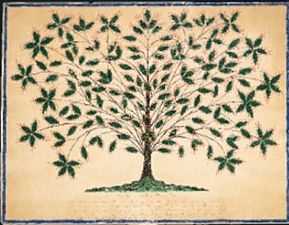Lucy Wright
 |
| Topics |
|---|
|
| Notable people |
|
Lucy Wright (February 5, 1760 – 1821) was the leader of the United Society of Believers in Christ’s Second Appearing, also known as the Shakers, from 1796 until 1821.[1] At that time, a woman's leadership of a religious sect was a radical departure from Protestant Christianity.[2]
Childhood
Lucy Wright was born February 5, 1760, the daughter of John and Mary (Robbins) Wright of Pontoosuck plantation (later Pittsfield, Massachusetts), in the Housatonic River valley of the Berkshire hills near the New York border.
At that time, Pontoosuck plantation was a frontier settlement, which was reached via path-like roads. Aside from Jonathan Edwards’ Indian mission in Stockbridge, the area had no church until Wright was almost thirteen.[3]
Wright was considered an attractive woman and a leader.[4] With Elizur Goodrich, she attended the New Light Baptist revival at New Lebanon, New York in 1779. Near the end of the revival, they heard a preacher expound on Romans 8:8 (“Those who are in the flesh cannot please God”), which may have set the stage for their conversion to a new religion.[5]
Marriage
Lucy Wright married Elizur Goodrich on December 15, 1779. They both became interested in the Shakers in 1780. Elizur Goodrich was impressed with the preachings of Mother Ann Lee, leader of the Shakers, and the new religion despite its requirements of celibacy and confession of sins.[6]
Goodrich and twenty members of his family joined the Shakers. After several months of deliberation, Wright resumed her maiden name and replaced her marriage with a commitment to Shakerism. Within a decade she had risen to leadership within the Shaker sect, with the power and authority which was not known in other religions.[7]
Life as a Shaker
As soon as Wright shifted her commitment from her husband to her new religion, Mother Ann Lee found it expedient to separate the young couple. She sent Goodrich on the road as an itinerant preacher and missionary. Wright moved to the Shaker community at Watervliet, New York, where Ann Lee mentored the young woman and she became a leader among her peers.
Ann Lee died in 1784. By late 1788, the society’s new leader Joseph Meacham had had a revelation that Shakers should practice equality of the sexes, or gender equality. He summoned Wright to New Lebanon, New York, and named her his female counterpart in leadership. Together, Meacham and Wright reshaped their religious society to include gender-balanced government, and gathering Believers into communal villages.[8]
Lucy Wright worked with Joseph Meacham until he died in 1796. After his death, Wright was the acknowledged leader of the Shaker ministry (a team of two elders and two eldresses who governed the society).
Wright proved to be a good administrator. She survived the exit of disaffected young men in the 1790s and sustained “petticoat government” for 25 years.[9] Her long tenure as the Ministry’s leader meant that she had ample opportunity to establish the principles of gender equality, and her leadership set an example for equality of the sexes.
Wright sent missionaries to preach across New England and upstate New York. After hearing of revivals at Cane Ridge, Kentucky (the Second Great Awakening), she sent missionaries into the western wilderness, where they recruited proselytes and established new Shaker villages in Kentucky, Ohio, and Indiana.[10]
Under Wright's administration, Shakers standardized and increased book and tract publishing for the widely-scattered religious society. Their first statement of beliefs was Testimony of Christ’s Second Appearing in 1810, followed by a hymnal which served much the same purpose in 1813.[11]
Lucy Wright preached union among her followers. One of her sayings was, "There is a daily duty to do; that is, for the Brethren to be kind to the Brethren, Sisters kind to the Sisters, and the Brethren and Sisters kind to each other."[12]
She died in 1821.[13] Her grave is beside that of Mother Ann Lee, in the Shaker cemetery in the Watervliet Shaker Historic District, now the town of Colonie, New York. Wright named her successors and her influence persisted because she was well-respected.
References
- ↑ Stephen J. Paterwic, Historical Dictionary of the Shakers (Lanham, Md.: Scarecrow Press, 2008), 250-51.
- ↑ Catherine A. Brekus, Strangers and Pilgrims: Female Preaching in America, 1740–1845 (Chapel Hill: University of North Carolina Press, 1998).
- ↑ Glendyne R. Wergland, Sisters in the Faith: Shaker Women and Equality of the Sexes (Amherst: University of Massachusetts Press, 2011), chapter 2.
- ↑ Anna White and Leila S. Taylor, Shakerism: Its Meaning and Message (Columbus, Ohio: Shakers, 1905).
- ↑ Wergland, Sisters in the Faith, chapter 2.
- ↑ White and Taylor, Shakerism: Its Meaning and Message.
- ↑ Wergland, Sisters in the Faith, chapter 2.
- ↑ Wergland, Sisters in the Faith, chapter 2.
- ↑ Jean Humez, “Weary of Petticoat Government”: The Specter of Female Rule in Early Nineteenth-Century Shaker Politics,” Communal Societies 11 (1991): 1-17.
- ↑ White and Taylor, Shakerism: Its Meaning and Message; Carol Medlicott, “Now By My Motion”: The Life Journey of Issachar Bates, Soldier, Preacher, and Shaker on the American Frontier (Hanover, N.H.: University Press of New England, 2013.).
- ↑ David Darrow, John Meacham, and Benjamin Seth Youngs, Testimony of Christ’s Second Appearing (Albany, N.Y.: Hosford, 1810); Millennial Praises: containing a collection of gospel hymns, in four parts, adapted to the day of Christ's second appearing, Seth Youngs Wells, comp. (Hancock, [Mass.]: Josiah Tallcott, Jr., 1813). See also Millennial Praises: A Shaker Hymnal, Christian Goodwillie and Jane Crosthwaite, eds. (Amherst, Mass.: University of Massachusetts Press, 2009).
- ↑ Mother Lucy’s Sayings, Sister Frances A. Carr, ed., (Poland Spring, Me.: United Society of Shakers, 1989), 105.
- ↑ Paterwic p. 251.
External links
- Mount Lebanon Shaker Society
- Mount Lebanon Shaker Village
- Mount Lebanon, World Monuments Fund
- Shaker Museum|Mount Lebanon